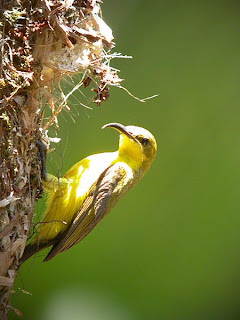A new website has just been launched to provide detailed information to help visitors to the daintree. You can check it out here:
Destination Daintree
Wednesday, March 31, 2010
Sunday, March 28, 2010
Regeneration in the Daintree
Many local companies are committed to sustainablity and have projects in place to minimize their impact on the local area.
Mason's Tours have just started to reveg a three hectare area adjacent to the site of their proposed rainforest centre, the process begins with killing the weeds and grass that prevents the natural regeneration. The site has been allowed to naturally regenerate over the past ten years and Mason's have now signed a Voluntary Declaration (VDEC) over it and plan to have it fully reveged over the next 15 years. The VDEC is their way of compensating for any potential damage done by the construction of boardwalks along Myall Creek.
The Daintree Discovery Centre is also heavily involved in local revegetation and is a Carbon Neutral company.
The picture above shows an area where introduced lantana has been killed and the area is now ready for replanting with native species
Tuesday, March 23, 2010
Birding updates
Mixed weather in the Daintree in the last fortnight with some heavy falls of rain mixed with hot and humid days and some gorgeous star-filled nights.
Some excellent birds seen locally with Little Kingfisher, Shining Flycatcher and Great-billed Heron on the Daintree River and Buff-breasted Paradise Kingfisher, Spotted Catbird and Victoria's Riflebird (all special rainforest birds) seen on the local birdwatching walk of Stewart Creek Rd near Daintree Village.
A Southern Cassowary has been a regular visitor to the Daintree Discovery Centre.
A favourite bird with locals is the Olive-backed Sunbird (previously called the Yellow-bellied Sunbird), who charms us all by building beautiful little hanging nests, often very close to human activity - in doorways, at the top of stairs etc. They are nectar feeders, but at this time of year when the flowers are wet, they will glean under the eaves of buildings gathering insects for food. Australia doesn't have any hummingbirds, and these little chaps are the closest thing we have with quite similar rapid wing movements.
The male has a bright blue-black chest, while the female has a plain yellow chest and belly.
Some excellent birds seen locally with Little Kingfisher, Shining Flycatcher and Great-billed Heron on the Daintree River and Buff-breasted Paradise Kingfisher, Spotted Catbird and Victoria's Riflebird (all special rainforest birds) seen on the local birdwatching walk of Stewart Creek Rd near Daintree Village.
A Southern Cassowary has been a regular visitor to the Daintree Discovery Centre.
A favourite bird with locals is the Olive-backed Sunbird (previously called the Yellow-bellied Sunbird), who charms us all by building beautiful little hanging nests, often very close to human activity - in doorways, at the top of stairs etc. They are nectar feeders, but at this time of year when the flowers are wet, they will glean under the eaves of buildings gathering insects for food. Australia doesn't have any hummingbirds, and these little chaps are the closest thing we have with quite similar rapid wing movements.
The male has a bright blue-black chest, while the female has a plain yellow chest and belly.
Wednesday, March 17, 2010
Cape Trib Road to be all weather
Thursday, March 11, 2010
Birdwatching in the Daintree
Welcome to the first of the updates on the birdlife of the Daintree.
A little background:
Daintree, in Tropical North Queensland, is internationally recognised as one of Australia's premier birdwatching locations. Over 430 species of birds have been recorded in the area encompassing the Wet Tropics and the Great Barrier Reef region of Australia. This is more than half the bird species for the entire continent. By combining visits to Daintree on the coastal lowlands, the upland rainforest of the Atherton Tablelands and the drier country of Mareeba and beyond, plus the tidal flats and off-shore islands, birders can appreciate the great diversity and number of the region’s birds within only 1 ½ hour’s drive from Cairns.
Summer migrants to Daintree, including Black Bittern, Buff-breasted Paradise Kingfisher, Pied Imperial Pigeon, Channel-billed Cuckoo and Metallic Starling, are seen from October/November until March/April, making it the best time of year for Daintree birdwatching, despite the chance of rain.
So, with this in mind, it is a fabulous time of the year to be birding in Daintree.
Recent sightings of interest include Southern Cassowary (both north and south of the Daintree River), Buff-breasted Paradise Kingfisher as they feed up their young preparing to fly back to New Guinea for the winter,
Great-billed Heron building a nest on the Daintree River, Azure Kingfisher and the elusive Little Kingfisher, who disappears into the Mangroves for breeding over the wet season, but is becoming much more visible again in the last week or so.
Subscribe to:
Posts (Atom)





